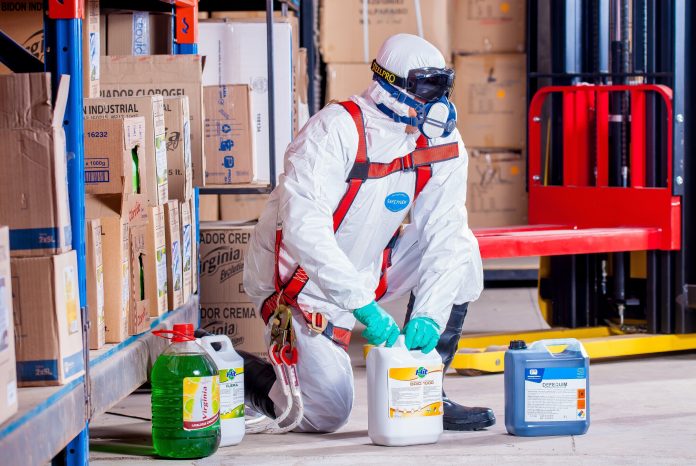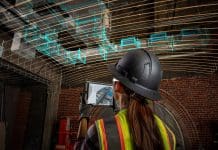Lucy Atkinson, business support manager at Genilogic, discusses how health and safety software helps reduce fatalities within the construction industry
The Health and Safety Executive (HSE) recently released statistics relating to RIDDOR reportable accidents and fatalities in 2018-19. Construction was the second most dangerous industry to work in last year with 20% of all workplace fatalities belonging to the industry (second to Agriculture, Forestry and Fishing with 21%). 30 workers arrived to work at the beginning of their shifts and never returned home. It is a sobering and shocking figure, especially when we are reminded this figure is workers only, a further 92 members of the public died last year as a result of work-based activities (total across all industries).
Quantifiable losses
In addition, another HSE report showed that 82,000 construction workers were suffering from new or long-term work-related injuries, illnesses or ill-health in 2018. Although we cannot quantify the effect on the lives of the people who make up these statistics and their family and friends, there are some things we can quantify.
- £490m – the economic cost of work-related injuries to the construction industry as a result of health and safety failings (2017/18)
- £571m – the economic cost of work-related illnesses to the construction industry as a result of health and safety failings (2017/18)
- £19m – the total amount of construction-related fines after prosecution for health and safety failings, giving an average of £98,000 per conviction (2017/18)
- £17,000 – the increase in an average fine from 2016/17 to 2017/18
- 2.4 million – the number of working days lost due to work-related illnesses and injuries (2017/18)
Source: HSE
There will be cases amongst these statistics where an injury, illness or fatality may well have been an unavoidable accident; however, the majority are due to health and safety breaches. It seems fair to say there is room for improvement with regards to protecting the health, safety and wellbeing of our workers.
Technical times
Meanwhile, the cloud is holding more of our data than ever before, with many businesses now operating with everything they need hosted elsewhere, enabling staff to connect in on any device, in any location, with an internet connection. The reason we are moving all our operations to the cloud is simple, we increase accessibility, traceability, productivity, functionality and safety, with the bonus of lowering resource costs and being eco-friendlier.
Construction in the Cloud
The application of technology is helping construction businesses in many new and innovative ways. An example for small businesses is having the option to work and store their data in the cloud, reducing costs for software, hardware, physical storage and support which are all now being replaced by monthly cloud-based software subscriptions, scalable to businesses. This gives small businesses access to the same resources as larger businesses at a fraction of the costs, making them competitive.

For larger businesses, technology is in everything we do, for example, using drones to take thousands of geo-tagged photographs takes just minutes as opposed to using manual methods and measurements which could take hours on large sites, whilst also removing the risk of human error in taking measurements, these images are uploaded directly to the cloud, giving instant access from anywhere in the world.
Making health and safety cool
Health and Safety management is now amongst business cloud-based offerings available on the market. Unfortunately, health and safety compliance has long been known as a checkbox exercise, it’s fair to say that Health and Safety were due a makeover. Slowly, cloud-based SaaS (Software as a Service) solutions have started to creep into the construction industry, not only improving the accessibility and visibility of important information, but also, improving the health and safety cultures within a workplace; something that is notoriously difficult to achieve.
Top 10 benefits to construction
There are many benefits for Construction companies looking to complement their current Health and Safety system with a cloud-based software solution, such as:
Visibility
Using software to host risk assessments, method statements, policies, procedures and news makes it easier to distribute critical information across sites and even countries. ’The Management of Health and Safety at Work Regulations 1992’ (Regulations 3 & 8) states that every employer must risk assessing the health and safety of all people who may be affected by work tasks. Employers must also provide employees with the assessment and any relevant information as well as implement any necessary controls to mitigate risk. Companies must be able to prove they have done this, typically this has meant lots of printing and posting. Using health and safety software to host these documents allows staff then log in from anywhere to read and acknowledge documents, giving a fully auditable and compliant system. Management can amend documents and resend them to reflect current projects or changes to procedure or environments without incurring costs.
Managing training
Construction is a complex industry and its workers have a variety of qualifications which are required before they may work on certain tasks or sites. Tracking course completions, expiry dates and refresher requirements can be very difficult and often issues can be spotted after expiry. Software solutions manage the training for a company, knowing what qualifications a staff member requires, then reminding them as it is due to expire and keeping management in the know. This works two ways too, so if a manager needs to locate a staff member with a forklift license for example, they can search the staff on their site and see who is qualified. Some solutions even come with inclusive courses to distribute to staff, adding value for money whilst ensuring companies are trained and compliant. Insurances and permits to work can be managed in the same way.
Health and safety reporting
Accident and incident reports are critical data to have available for businesses to both maintain and improve high safety standards. Unfortunately, many accidents, incidents and hazards go unreported due to staff not realising the importance and power of this data. In making reporting systems accessible to everyone from their own devices, it makes staff more likely to report than if they had to make a call or visit an office to do so.

It is also good for staff to know that reporting is a recognised part of health and safety management, having the module there in some ways shows its importance. The benefits of management having digital reports of accidents for the full company, irrespective of location, are that it gives an insight into where the company can improve safety measures.
Some solutions even group accident by task and come with accident review tools to not only make operations safer, but also to enable a company to show they take both a proactive and reactive approach to safety. Having these statistics also enables the implementation of annual KPIs for accidents, incidents and hazards.
Mental health support
Construction companies are under pressure at the minute to improve their provision of mental health support as statistics have shown an epidemic of mental health issues in the industry. Giving all staff access to a health and safety software system gives a business an easy way of distributing support and information and communication with staff.
The policies and news modules within a software solution, or even a site risk assessment, can be used to store the details of onsite mental health first aiders and how to contact them. The system could also house the contact details of local services and charities which offer mental health support and services. Having this data available 24-7 to staff is invaluable, often people are embarrassed or unable to ask for help due to their illnesses, if they could find relevant information on the system it may enable them to reach out or engage with support. The system can also house information regarding what support is available or mental health management plans for staff suffering with mental health difficulties so they know what support they can ask for and how to arrange it.
Dynamic risk assessments
One of the biggest challenges to compliance in the construction industry is the ever-changing work environment. Ever-changing locations and conditions can make planning works very difficult as often, you don’t know the risks until you arrive onsite. This has tended to see construction companies operating with a collection of task-specific risk assessments which are to apply to the task no matter where it is being completed. These documents are then complimented by a site risk assessment. Whilst this would pick up obvious risks, it often doesn’t take into consideration the additional risks of the specific tasks on that specific site.
Using software would allow managers to pick up a task risk assessment and clone it to then add in site specific risks, using a risk library to pick applicable risks, making identifying risks easier. These new assessments can then be distributed instantly for acknowledgement, something almost impossible to do with static or manual systems. Managers can then ensure all staff have acknowledged the documentation before they allow works to commence, all from the device in their pocket.
Language barriers
Translating health and safety documents into another language for a non-native speaking worker can run into the thousands cost wise, however, not translating these could result in large fines and prosecutions. Aside from the risk of fines, it is a concern having a staff member on site who may not understand the safety requirements or how to complete tasks compliantly. Now health and safety software solutions come with translation tools which can translate full documents in one click, enabling peace of mind for everyone involved as well as equal opportunities for all staff whilst protecting a business’s reputation and company standards of work.
COSHH management
Control of Substances Hazardous to Health (COSHH) is in place to protect people from injuries or illnesses which come from exposure to certain substances, whether by contact, inhalation, ingestion or through an open wound. Every COSHH product used in the UK must have a Safety Data Sheet (SDS) as well as appropriate labelling/packaging. Often, manufacturers release newer, updated SDS and this information must be circulated to all workers who work with the product.
Staff must also be given the appropriate tools, conditions and personal protective equipment (PPE) to safely work with COSHH products. Keeping and distributing a full library of COSHH SDS can be a full-time job in some companies due to the sheer number of products used. Software solutions often offer COSHH management, which is provided by storing all SDS, updating them automatically, linking them to task risk assessments and distributing them for acknowledgement and storing them for anytime access, along with all the label elements and PPE requirements.
Collaboration
Many solutions offer the option to add contractors and subcontractors onto your account to have them read your policies and procedures and enter in their course completions, insurance details and any permits to work. Often this process can be disjointed, resulting in contractors being at the root of many RIDDORs whether as the victim or the cause.
The fact is, whether a worker is an employee, a contractor or sub-contractor, if they are working on behalf of a company, they must work compliantly, or the company may be found liable. Giving all workers access to the same system not only protects their health safety and wellbeing, it protects the companies brand and reputation as well as protecting the company from expensive fines and prosecution.
Some solutions offer the facility for separate companies to join their accounts together during projects so if several companies are working together, compliance is shared and a joint responsibility rather than something everybody thought somebody else overseeing. This collaborative approach also gives visibility across a site of problems such as accident reports, allowing all companies to react together to data to protect all workers on a site.
Keeping data safe
In an era where data protection and GDPR laws are at the forefront of every company’s mind, knowing data is safe, compliant and secure is more important than ever. Using paper systems for health and safety is not just expensive and hard to manage, it poses the risk of confidentiality breaches. Storing company information in a cloud-based system which is encrypted, and password protected is in line with best practises.
Software providers should also have provisions to ensure that workers each only see what they need to for their job roles. This is a much better way for managing all things health and safety, but as an example, having a secure system replace the accident book which was previously available for anyone to see as they add in entries offers workers confidentiality that may have previously put them off reporting accidents. Paper is also often very impracticable to reach staff in remote areas where they may be working alone or short-term.
Having an auditable system
Often, companies do everything they can to ensure they have a compliant system, they create and store all the correct documentation and implement all possible controls, however, without an audit trail, the system offers them no support in an investigation. Companies need to be able to show that not only the policies, procedures and risk assessments are in place, but that they have also been distributed, understood and acknowledged.
Companies must also have records of all training completed and due. As construction is such a high risk environment, some could argue that it is even more important to have the ability to prove that all reasonably practicable steps had been taken with all legislation in mind, to protect the health, safety and wellbeing of every worker under their instruction and care.
Help with compliance
It is important to recognise that whilst a software solution can help companies save time and resources to manage health and safety more effectively, it does not replace the need for a health and safety consultant, department or professional to be employed by a business. Software is designed to give health and safety professionals an appropriate way of managing and distributing documentation whilst giving them an easier way to find barriers to compliance in expiring or overdue actions within a company.
It is possible for a company to almost completely self-manage their compliance using software, however, having a professional come in to assess risks and advise on appropriate measures to manage and mitigate risk is still needed when processes are added, changed or require review.
Why are we holding back?
As ever, cost is one of the biggest reason that health and safety software has not been adopted in many companies, however it is likely that most companies simply do not realise how much they already spent annually on compliance, or the risks they are running by operating non-compliantly.
The first thing to look at is your current system, reviewing it for compliance. If it is already compliant, review costs in the last year to determine how much your compliance cost you in man-hours, consultancy costs, reviews, print outs and the cost of any courses your staff have undertaken. If your system is non-compliant, review where it lacks and try to make an accurate guestimate on the amount it would cost to put more resources into your current system to make it compliant. Once you have this figure, you are much better placed to pick a solution which is suited to you.
Conclusion
As someone who works for a health and safety software company, I have it on good authority that companies that have implemented a solution report significant improvement in staff engagement with health and safety. It is said to improve staff attrition through staff feeling more valued and involved in their own wellbeing.
Alongside this, companies report feeling more in control of their health and safety obligations and more proactive about improving safety. Will you wait to find out the 2019 average cost of non-compliance, or will you look for a simpler solution?
Lucy Atkinson
Business support manager
Genilogic

















